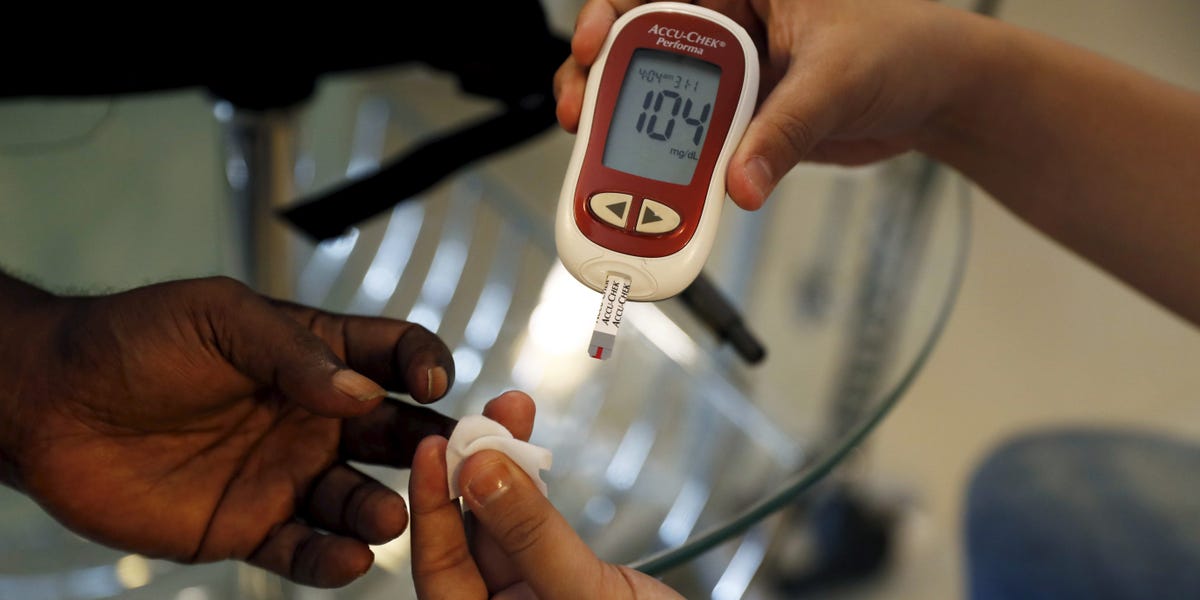
- Many people don’t know they have diabetes since initial symptoms can be subtle, an expert said.
- Signs like dark skin patches, slow-healing wounds, or frequent bathroom trips may indicate diabetes.
- Breath that smells like acetone may signal a life-threatening complication of diabetes.
More than 10% of the US population has diabetes, and one out of every five of them isn’t aware they have the disease, according to the American Diabetes Association.
Prediabetes can be often occur without symptoms, making it difficult to recognize without bloodwork or until it develops into type 2 diabetes, according to Dr. Nuha El Sayed, vice president of healthcare improvement for the American
Diabetes
Association.
“It can take years to develop. A lot of times, people walk around and they don’t know,” she told Insider.
But certain telltale cues can help you determine if you may have diabetes. Changes to your skin, weight, and bathroom habits could all suggests problems with blood sugar control — although no single symptom necessarily means you have diabetes, experiencing several may warrant a trip to the doctor, El Sayed said.
Developing darker patches of skin may be a sign of diabetes
One less commonly discussed sign of diabetes is changes in to skin tone and texture, often occurring at joint creases such as the nape of the neck or under the arms, according to El Sayed.
The patches can be triggered by high levels of insulin, causing skin cells to grow more rapidly. Technically known as “acanthosis nigricans”, the discoloration can occur in people of any skin tone.
“It may be easier to detect in people with fair skin, but in people with darker skin you can still see it in comparison to the surrounding area,” El Sayed said.
The texture of the skin may also change, becoming thicker or developing a velvety feel.
Slow-healing wounds or frequent infections can be caused by high blood sugar
If small injuries like scrapes and bruises don’t heal, you might have high blood sugar related to diabetes, El Sayed said.
Uncontrolled diabetes can lead to elevated blood sugar levels, which can slow circulation, interfering with the body’s ability to heal. As a result, you may not recover as quickly from injuries, and open wounds may be more prone to infection.
You may also be more susceptible to other types of infection, including yeast infections or skin infections.
Having to pee more often, or more urgently, is a red flag
Another classic indicator of diabetes in more frequent urination.
What counts as “frequent” can vary — it might be as many as 20 trips to the bathroom in a day for some people, but could also be much more subtle, according to El Sayed.
“If you typically go 2 or 3 times a day, and are suddenly going 8 times a day, that may be a problem,” she said.
Increased urgency, or an inability to make it to the bathroom in time, is another warning sign.
“If you find yourself restricting the amount of water you drink, that’s not good,” El Sayed said.
Sudden, unexplained weight loss is reason for testing
Abruptly losing weight may be another indicator your body isn’t able to manage blood sugar or insulin.
Weight loss
could have many explanations, not just diabetes, but combined with other symptoms is good reason to get tested, El Sayed said.
If your breath smells like nail polish remover, you may need serious medical attention
Many common signs of diabetes are reason to make a doctor’s appointment, but in some cases, more urgent medical care is required.
Smelling acetone or nail polish remover on someone’s breath could be a sign of a life-threatening condition called diabetic ketoacidosis. The telltale smell, shortness of breath, or changes to your mental state such as disorientation or forgetfulness are reason to seek medical help immediately, El Sayed said.


